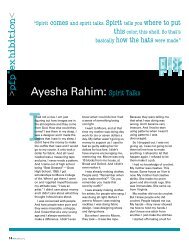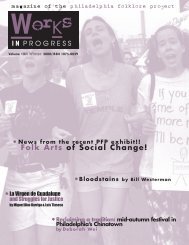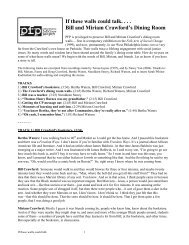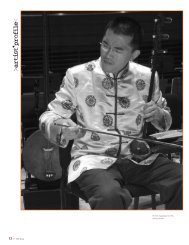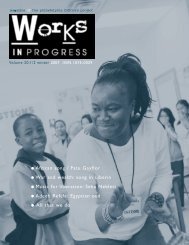The Big Red Songbook: - Philadelphia Folklore Project
The Big Red Songbook: - Philadelphia Folklore Project
The Big Red Songbook: - Philadelphia Folklore Project
You also want an ePaper? Increase the reach of your titles
YUMPU automatically turns print PDFs into web optimized ePapers that Google loves.
point*of view<br />
<strong>The</strong> <strong>Big</strong><br />
<strong>Red</strong><br />
<strong>Songbook</strong>:<br />
100 Years<br />
of Wobbly<br />
Songlore<br />
Few workers’ associations<br />
in the United<br />
States exist long<br />
enough to celebrate<br />
their centennials. Trade<br />
unions, fraternal organizations,<br />
and neighborhood alliances all<br />
fall victim to shifts in ideological<br />
or physical environments.<br />
Before a labor union reaches its<br />
hundredth year, it is likely to<br />
have merged with parallel or<br />
subordinate groups. Thus, members<br />
face their anniversaries<br />
with diverse feelings: do we<br />
honor old age alone; is it only<br />
survival that matters; or, alternately,<br />
do we elevate a particular<br />
symbolic emblem or special<br />
formulation to represent<br />
out identity?<br />
From its inception in Chicago<br />
in 1905, the Industrial Workers<br />
of the World chose as its guiding<br />
cause revolutionary industrial<br />
unionism. To the extent that<br />
IWW members concerned themselves<br />
consciously with cultural<br />
theory, like rival radicals, they<br />
relegated expressive material<br />
to an auxiliary role. In short,<br />
bedrock economic struggle<br />
took priority over secondary<br />
artistic forms.<br />
Songs, stories, sayings, skits<br />
and related ephemera commented<br />
upon class conflict, but did<br />
not rise to the level of direct<br />
action in mine, mill, forest or<br />
factory. Whether rebel viewed<br />
work through Darwinian or<br />
Marxian eyes, each job site<br />
determined the contour of life<br />
itself. A song, however categorized,<br />
might ease a worker’s<br />
pain, help in getting through the<br />
day, or, even beyond individual<br />
needs, assist in transforming<br />
society.<br />
As 2005 approached, in recognition<br />
of the IWW’s centennial, a<br />
group of friends discussed the<br />
possibility of publishing <strong>The</strong> <strong>Big</strong><br />
<strong>Red</strong> <strong>Songbook</strong>, a comprehensive<br />
gathering of songs and<br />
poems as they appeared in the<br />
various editions of the IWW’s<br />
“Little <strong>Red</strong> <strong>Songbook</strong>.” <strong>The</strong>se<br />
individuals did not constitute a<br />
formal (or even an ad hoc) editorial<br />
committee. We undertook<br />
to research and write the various<br />
portions of the new edition,<br />
forthcoming from the Charles H.<br />
Kerr Publishing Company. It is<br />
my task, here, to present an<br />
overview of IWW songlore.<br />
Even before the IWW’s formal<br />
chartering a hundred years ago,<br />
farsighted industrial unionists<br />
spoke in many tongues reflecting<br />
different nativities and<br />
philosophies. Accepting the<br />
responsibility of building a thennew<br />
workers’ movement, laborunion<br />
loyalists, anarcho-syndicalists,<br />
and socialists framed<br />
their messages in a rainbow of<br />
voices. Similarly, hard-rock miners,<br />
straw cats who harvested<br />
wheat, fruit and other crops,<br />
lintheads in textile mills,<br />
mariners, castaways and wanderers<br />
shouted or whispered as<br />
their separate skills demanded.<br />
Some IWW writers and orators<br />
both in their journalism and<br />
10 WIP 2006-2007 Winter
y Archie Green<br />
Flyer for striking<br />
IWW members,<br />
1920s, and Little<br />
<strong>Red</strong> <strong>Songbook</strong>.<br />
From PFP<br />
archives.<br />
soapboxing mastered high<br />
rhetoric; others favored vernacular<br />
style. Readers of the IWW<br />
press and street-corner listeners<br />
encountered language derived<br />
from Shakespeare and Shelley,<br />
as well as the saloon and the<br />
brothel. Unlike many radicals<br />
before and after 1905, the IWW<br />
accepted strange accents, surreal<br />
deliveries, zany humor, and pungent<br />
cartoons as proper in the<br />
organization’s discourse.<br />
IWW words declaimed or sung<br />
in poem and song functioned<br />
similarly to those in writing.<br />
Industrial-union pioneers did not<br />
create a rich body of songlore<br />
either by calculated design or by<br />
divine inspiration. Rather,<br />
founders came to Chicago well<br />
acquainted with plural musical<br />
genres: classical radical fare (e.g.<br />
items in Socialist Songs with<br />
Music, issued by Charles Kerr,<br />
1901); popular hits of stage and<br />
parlor (Stephen Foster to Irving<br />
Berlin); evangelical hymns<br />
(Dwight Moody and Ira Sankey);<br />
traditional occupational folksong<br />
(not yet gathered in published<br />
anthologies but present in<br />
plural craft, regional, and ethnic<br />
communities).<br />
In short, to understand the<br />
IWW’s contagious musical blend,<br />
one must hear in the mind’s ear<br />
rebel unionists who knew<br />
“L’Internationale” and “La<br />
Marseillaise,” as well as homespun<br />
shanties and ballads indigenous<br />
to ranch bunkhouse, hobo<br />
jungle, or mountain mining<br />
camp. Before and during the<br />
IWW’s formative years, textile<br />
workers literally sang “Hard<br />
Times in the Mill”; coal diggers<br />
and hard-rock “ten-day stiffs”<br />
shared the mournful “Only a<br />
Miner”; itinerant toilers along<br />
countless miles of railroad tracks<br />
spun out pieces such as “<strong>Big</strong><br />
Rock Candy Mountain”— in<br />
straight or bawdy form, compensatory<br />
vehicles for rootlessness.<br />
Of the many musical idioms<br />
available to IWW members, one<br />
form dominated: the polemical.<br />
With the appearance of IWW<br />
newspapers (Industrial Worker,<br />
Spokane; Solidarity, Cleveland),<br />
readers submitted new tests usually<br />
set to then-popular vaudeville<br />
tunes or gospel-hymn standards.<br />
Editors varied in their<br />
reception to minstrel contributions;<br />
they printed some items in<br />
their journals and others on<br />
pocket-sized cards, reminiscent<br />
of earlier broadsides. In 1909, the<br />
Spokane IWW branch gathered<br />
two dozen numbers, new and<br />
old, into a red-jacketed booklet<br />
titled Songs of the Industrial<br />
Workers of the World.<br />
In 1968, Richard Brazier reminisced<br />
about his role on the committee<br />
which prepared the first<br />
songbook. A few of his words<br />
reveal the editors’ rationale:<br />
“…to destroy the old myths that<br />
have enslaved us for so long. We<br />
will have songs that hold up<br />
flaunted wealth and threadbare<br />
morality to scorn, songs that<br />
lampoon our masters…[Our<br />
songbook] will exalt the spirit of<br />
Rebellion.”<br />
Subsequent editors in 1910-11<br />
added phrases to the booklet’s<br />
title such as Songs of the<br />
Workers: On the Road, in the<br />
Jungles, and in the Shops; Songs<br />
to Fan the Flames of Discontent.<br />
No one knows who first tagged<br />
this gathering the “Little <strong>Red</strong><br />
<strong>Songbook</strong>.” It proved to be the<br />
IWW’s most popular publication;<br />
it caught on beyond the Union’s<br />
ranks.<br />
<strong>The</strong> nickname “Wobbly” began<br />
circulating in 1913-1914; it has<br />
been joined at the hip to the<br />
organization’s songbooks. In continuous<br />
print from 1909 to the<br />
present, these booklets have<br />
gone through 37 editions.<br />
(Bibliographers still puzzle over<br />
the exact number of printings<br />
and the sequence of editions.)<br />
Over the years, editors have<br />
deleted particular items either for<br />
dated content, in response to<br />
[Continued on p. 27 ➝]<br />
2006-2007 Winter WIP 11
losang samten/continued from p. 26<br />
sand mandala supervisor for<br />
Martin Scorsese’s film Kundun.<br />
He has been recognized with<br />
a 2002 National Endowment for<br />
the Arts National Heritage<br />
Fellowship in honor of his<br />
accomplishments as a sand<br />
mandala artist, as well as a Pew<br />
Fellowship in the Arts in 2004.<br />
Losang makes annual trips to<br />
India, where he continues to<br />
learn from the Dalai Lama and<br />
other spiritual leaders and<br />
artists, studies mandala imagery<br />
in caves and old temples, and<br />
meditates. Because of travel<br />
restrictions and his relatives’<br />
lack of access to phones and<br />
computers, he cannot communicate<br />
with family members who<br />
remain in their small village in<br />
Tibet. He worries about them<br />
and about the future of Tibet<br />
and its rich culture. He attempts<br />
to better the world through his<br />
art and by leading others on<br />
meditation retreats, although he<br />
left the monkhood in 1994.<br />
Mandalas and spirituality are<br />
inextricably intertwined. As he<br />
explains, “<strong>The</strong> Buddha himself<br />
has been seen as a great artist,<br />
as one who has reached into<br />
deeper understandings of reality.<br />
I retreat and meditate to<br />
reach towards better understanding,<br />
too, and portray my<br />
point of view in my art.”<br />
This last quotation is from an<br />
interview by the author with Losang<br />
Samten published in PFA, the<br />
newsletter of the Pew Fellowships<br />
in the Arts (fall/winter 2004), p. 6.<br />
Losang will be<br />
artist- in-residence<br />
at the<br />
Folk Arts<br />
Cultural Treasures<br />
Charter School<br />
this winter.<br />
wobbly songs/continued from p. 11<br />
change by members in personal<br />
taste, or in reaction to external<br />
issues. At times, behind-thescenes<br />
debate on difficult<br />
pieces has revealed switches in<br />
position on large conceptual<br />
matters: job action, sabotage,<br />
lifestyle, gender, relations with<br />
other left-sectarian groups.<br />
Although the IWW discouraged<br />
personality cults within its<br />
ranks, songwriter Joe Hill<br />
achieved legendary status initially<br />
among industrial unionists<br />
and subsequently in a larger<br />
group of CIO members, urban<br />
liberals, and unaffiliated radicals.<br />
Hill’s life as a Swedish<br />
emigrant to the United States,<br />
his capacity to pen two dozen<br />
new Wobbly songs within a<br />
five-year span, his trial for murder<br />
and death by firing squad in<br />
Salt Lake City (1915), and unresolved<br />
questions of guilt or<br />
innocence combined to elevate<br />
him into the workers’ pantheon.<br />
<strong>The</strong> extensive literature on<br />
Joe Hill (by writers such as<br />
Ralph Chaplin, Joyce Kornbluh,<br />
Franklin Rosemont, Gibbs<br />
Smith, Barrie Stavis, and<br />
Wallace Stegner) leads readers<br />
beyond biography to searching<br />
questions on the nature of<br />
Wobbly lore and its “fit” as a<br />
chip in the mosaic of labor’s<br />
heritage. IWW poets/composers<br />
strove to nurture revolutionary<br />
consciousness. Each piece—<br />
whether topical, hortatory, elegiac,<br />
sardonic, or comic—<br />
served to educate, agitate, and<br />
emancipate workers. Songs<br />
were intended as arrows to<br />
penetrate bourgeois (in Wobbly<br />
parlance, “scissorbill”) mentality,<br />
and to anticipate a new<br />
social order—the commonwealth<br />
of toil.<br />
In everyday practice as<br />
Wobblies sang at jungle campfires,<br />
in meeting halls, and during<br />
free speech rallies, much of<br />
their repertoire melted away.<br />
Some lyrics proved too taxing<br />
to sing; in short, they were<br />
unsingable. Others had been set<br />
to tunes that lost out in style<br />
wars. Still others became irrelevant<br />
as the IWW declined.<br />
However, a handful entered<br />
tradition—a few as folksongs,<br />
some as labor-union classics.<br />
Not all IWW members have<br />
enjoyed sharing material across<br />
institutional lines, nor upon<br />
hearing treasures performed by<br />
rivals: pragmatic craft unionists,<br />
reformist allies, left partisans.<br />
Wobblies known for militancy<br />
on the job and life-defying bravery<br />
on the strike front were<br />
powerless to control the trajectory<br />
of their songs, or to determine<br />
life or death for given<br />
pieces. As their material<br />
reached large society, Wobblies<br />
responded ambivalently—<br />
happy that the Union had gone<br />
beyond its ranks; dismayed that<br />
strangers might distort the<br />
IWW’s inherent message.<br />
Three books in particular<br />
measure the spread of IWW<br />
songlore outside the organization’s<br />
bounds. In 1909, Paul<br />
Brissenden, a California student<br />
in Economics, became interested<br />
in labor. In 1919, the<br />
Columbia University Press published<br />
his <strong>The</strong> IWW: A Study in<br />
American Syndicalism which<br />
included thirteen songs. In<br />
1923, the University of Chicago<br />
Press issued Nels Anderson’s<br />
<strong>The</strong> Hobo, an influential study<br />
of homeless men. It held four<br />
IWW songs.<br />
Carl Sandburg’s <strong>The</strong><br />
American Songbag (1927)<br />
appealed well beyond campus<br />
walls with three Wobbly numbers.<br />
Sandburg conferred folksong<br />
rank for “<strong>The</strong> Preacher<br />
and the Slave.” Under varied<br />
titles (“Long Haired Preachers,”<br />
“Pie in the Sky”) Joe Hill’s parody<br />
of the hymn “Sweet Bye and<br />
Bye” moved out of labor’s<br />
sphere to comment upon moral<br />
values in the American polity.<br />
Ironically, a song introduced<br />
[Continued on next page ➝]<br />
2006-2007 Winter WIP 27
wobbly songs/continued from p. 27<br />
outside the IWW orbit yet<br />
memorializing Hill achieved<br />
more fame than most pieces in<br />
the Wobbly canon. “Joe Hill”<br />
opens with “I dreamed I saw<br />
Joe Hill last night alive as you<br />
and me.” It has been sung by<br />
Joan Baez, Billy Bragg, Joe<br />
Glazer, Paul Robeson, Pete<br />
Seeger and many others. Alfred<br />
Hayes (lyrics) and Earl<br />
Robinson (music) offered it initially<br />
in 1936 at Camp Unity<br />
near New York City. <strong>The</strong>ir gift—<br />
forged on a Communist Party<br />
Popular Front anvil— has<br />
sometimes been erroneously<br />
attributed to Hill himself by<br />
commentators who allege that<br />
he composed it as a salute to<br />
fellow workers and a projection<br />
of his immortality.<br />
A few words on the troublesome<br />
matter of definition may<br />
help new readers in their evaluation<br />
of Wobbly songs. Most of<br />
the items gathered in <strong>The</strong> <strong>Big</strong><br />
<strong>Red</strong> <strong>Songbook</strong> are no longer<br />
sung, but remain of interest to<br />
historians, sociologists, and a<br />
few labor-union partisans.<br />
Although the very first booklet<br />
held a traditional parody cherished<br />
by itinerant workers,<br />
“Hallelujah, I’m a Bum” (irreverently<br />
titled “Hellelujah”), the<br />
IWW paid no special attention<br />
to folklore theory, or the supposed<br />
values inherent in folksong.<br />
In the mid-1930s, some<br />
American communists touched<br />
by Popular Front ideology<br />
embraced folksong. This commitment<br />
carried through until<br />
the 1970s “folk boom,” but it<br />
did not hold much appeal to<br />
Wobblies. However, the thirtyfourth<br />
edition songbook (1973),<br />
overturned precedent by including<br />
Woody Guthrie’s “Union<br />
Maid.” <strong>The</strong> thirty-fifth edition<br />
(1984), extended the process<br />
with Les Rice’s “Banks of<br />
Marble.” <strong>The</strong>se two pieces represent<br />
“People’s Songs” intrusions<br />
in time-tested IWW repertoires.<br />
<strong>The</strong> subject of “intrusion”<br />
has, and continues to be, controversial.<br />
During the 1920s and<br />
‘30s, IWW activists opposed<br />
Communist Party policies.<br />
However, by the 1970s, with the<br />
passing of many old-timers,<br />
young Wobblies were less<br />
invested in maintaining sectional<br />
differences. In this context,<br />
“Union Maid” became acceptable<br />
to the IWW.<br />
Beyond the merits of enlarging<br />
a songbook with “outside”<br />
material, labor partisans face a<br />
difficult question: pop culture’s<br />
influence on Wobbly expression<br />
(characterized by Franklin<br />
Rosemont in his study Joe Hill,<br />
2003, as “revolutionary working-class<br />
counterculture”). I ask:<br />
Should Wobblies have resisted<br />
Popular Front formulas and<br />
“folksong revival” fare? What<br />
are this dilemma’s implications<br />
for labor unionists in their cultural<br />
decisions? How do we<br />
navigate between contestational<br />
and conciliatory strategies?<br />
Present-day IWW activists<br />
divide in assessing their musical<br />
heritage. Some assert:<br />
“Economic forces outweigh cultural<br />
expression; we need only<br />
to alter conditions at the point<br />
of production; class struggle<br />
relegates songlore to a derivative<br />
role.” Others suggest that<br />
IWW songs captured the<br />
union’s spirit better than its<br />
manifestoes, pamphlets, and<br />
proceedings. “We should not<br />
apologize for our songs; rather<br />
let’s use them as ambassadors<br />
to working people wherever<br />
they toil.”<br />
Today, Wobbly songs seem<br />
suspended between cultural<br />
domains. Most are obscure; a<br />
few live in tradition. Not one<br />
has achieved national popularity<br />
associated with Broadway,<br />
Nashville, or Hollywood.<br />
Nevertheless, labor activists<br />
treasure the corpus for internal<br />
cheer, oppositional message,<br />
and humane promise.<br />
Essentially, each Wobbly song<br />
that carries into the twenty-first<br />
century will affirm the linkage<br />
of poetry to cause, as well as<br />
music’s use in defining individual<br />
and social identity.<br />
My sketch above offers some<br />
generalizations about Wobbly<br />
songs. Here, I turn to a few of<br />
the issues faced by the informal<br />
committee of friends responsible<br />
for <strong>The</strong> <strong>Big</strong> <strong>Red</strong> <strong>Songbook</strong>.<br />
To identify myself: I have<br />
worked first as a shipwright<br />
and later as a teacher. Although<br />
sharing many Wobbly values, I<br />
am not an IWW member. In<br />
studies over the years, I have<br />
probed for the IWW’s place in<br />
creating and extending laborlore.<br />
My views reflect tradeunion<br />
experience and academic<br />
folklore training.<br />
Included in <strong>The</strong> <strong>Big</strong> <strong>Red</strong><br />
<strong>Songbook</strong> is the essay “John<br />
Neuhaus: Wobbly Folklorist” as<br />
I penned it nearly half-century<br />
ago. Today, it can be read as a<br />
memorial to a friend and fellow<br />
worker. Also, it is a road marker<br />
on a still incomplete journey.<br />
Do we feel obligated to continue<br />
John’s exact path, or are we<br />
free to set off in new directions?<br />
John Neuhaus was passionate<br />
in his belief that Wobblies<br />
and friends should continue to<br />
sing all the numbers in the<br />
IWW songbooks (issued before<br />
his death in 1958). With the<br />
centennial behind us, I do not<br />
share John’s vision, for I<br />
believe that most of the inclusions<br />
retain value as cultural or<br />
historical artifacts, but not as<br />
songs in the repertoires of living<br />
singers.<br />
In the chronological and<br />
alphabetical check lists in the<br />
<strong>Big</strong> <strong>Red</strong> <strong>Songbook</strong>, we note all<br />
songs to date. However, in our<br />
main text, we reprint only those<br />
items through the thirty-fourth<br />
edition. This decision is arbitrary;<br />
it will not satisfy all<br />
enthusiasts; it raises the puzzling<br />
question: What is a<br />
Wobbly song? Is it any piece<br />
printed in an IWW songbook, or<br />
just those that reflect IWW philosophy?<br />
Who decides the contours<br />
of Wobbly belief?<br />
Almost all Wobbly songs<br />
[Continued on naxt page ➝]<br />
28 WIP Winter 2006-2007
wobbly songs/continued from p. 28<br />
have been recorded by interpreters<br />
rather than by traditional<br />
singers. This dichotomy has<br />
raged in “folksong revival” circles.<br />
I shall not repeat the tired<br />
arguments here. However, I do<br />
stress that very few Wobblies<br />
made field recordings in traditional<br />
style. Does anyone who<br />
desires to understand IWW lore<br />
not wonder how the songs<br />
were performed when first<br />
introduced to copper-camp miners,<br />
factory-line workers, or<br />
their many peers?<br />
Wobblies faced harrowing<br />
regional, linguistic, and social<br />
barriers among men and<br />
women awaiting organization.<br />
To cite an instance: when a new<br />
little red songbook appeared in<br />
an East Texas piney-woods<br />
camp or a Louisiana cypressmill<br />
town, did the workers<br />
involved sound alike? It defies<br />
reason to suggest that individuals<br />
of varied descent (Anglo,<br />
African, Mexican) in the IWWaffiliated<br />
Brotherhood of Timber<br />
Workers approached material in<br />
a singular voice. By imagining<br />
these diverse woods singers in<br />
their particular styles, we arrive<br />
at a pluralistic view of IWW lore<br />
more challenging than the<br />
“folksong-revival” flavored<br />
items in the present discography.<br />
For many musical genres,<br />
loyal fans have produced LP or<br />
CD compilations based on<br />
ethnographic and historical<br />
research. Such an album of<br />
Wobbly songs is long overdue.<br />
It might recreate the sounds of<br />
a century-old Sousa brass band<br />
as well as an early ragtime<br />
ensemble. What did Richard<br />
Brazier experience when he<br />
took in a Spokane vaudeville<br />
show? Has any Wobbly commented<br />
on his exposure to a<br />
barrelhouse piano or a parallel<br />
off-color ditty? Fred Thompson<br />
has described hearing old<br />
Chartist hymns in his native<br />
Nova Scotia. Where did other<br />
unionists become familiar with<br />
camp-meeting hymns and<br />
gospel favorites? <strong>The</strong> challenge<br />
is great; the task lies before<br />
present enthusiasts.<br />
I see no contradiction<br />
between the act of preparing a<br />
retrospective IWW album and<br />
continued effort to compose<br />
and circulate new material.<br />
Bibliographic and discographic<br />
tools will provide useful in this<br />
task of reconstruction. Readers<br />
will observe that <strong>The</strong> <strong>Big</strong> <strong>Red</strong><br />
<strong>Songbook</strong>’s two checklists hold<br />
only English-language material.<br />
Hence, future fans can expand<br />
these lists to include IWW songbooks<br />
in various tongues.<br />
Wobblies printed Swedish<br />
songbooks both in the United<br />
States and Sweden. However,<br />
our present knowledge of other<br />
foreign-language editions is<br />
incomplete. Similarly, our<br />
discography cries for expansion.<br />
<strong>The</strong>se gaps in documentation<br />
are especially ironic in that<br />
Wobblies were far ahead of<br />
rival trade unionists in organizing<br />
immigrants regardless of<br />
race or speech.<br />
In closing this overview, I am<br />
also aware of the end of a personal<br />
journey. Like other children<br />
of immigrants, I attended<br />
a Workman’s Circle school in<br />
the mid-1920s. <strong>The</strong>re we<br />
learned labor songs, including<br />
IWW classics. Too young to discern<br />
the school’s politics, I associated<br />
these songs with the<br />
campaign to save Sacco and<br />
Vanzetti from the electric chair.<br />
In retrospect, it was a noble<br />
cause and a memorable introduction<br />
to Wobbly music.<br />
Massachusetts executed the<br />
two Italian anarchists on August<br />
23, 1927. I have sung, studied<br />
and puzzled over IWW material<br />
in all the following decades.<br />
Much of what is stated in this<br />
preface repeats earlier formulations.<br />
Some of my views are<br />
commonplace; others, controversial.<br />
I have already alluded<br />
above to the thorny matter of<br />
definition for Wobbly songs;<br />
this problem remains unresolved.<br />
I am convinced that<br />
some of <strong>The</strong> <strong>Big</strong> <strong>Red</strong><br />
<strong>Songbook</strong>’s pieces proved difficult,<br />
if not impossible, to sing at<br />
the time of their composition.<br />
Others caught on with singers;<br />
they circulated widely and were<br />
altered in the process.<br />
Scholars fall back on two<br />
basic beliefs: a song may enter<br />
tradition; folksongs show variation<br />
over time and place. Before<br />
the popular interest in folksong<br />
in the 1970s, IWW members<br />
paid little attention to academic<br />
issues in defining their music.<br />
Some of these problems in<br />
status and meaning are illustrated<br />
by “<strong>The</strong> Dehorn,” an<br />
irreverent parody set to the<br />
tune of “<strong>The</strong> <strong>Red</strong> Flag.” It<br />
opens:<br />
<strong>The</strong> dehorn’s nose is<br />
deepest red,<br />
<strong>The</strong> one bright spot in<br />
his empty head,<br />
To get his booze he begs<br />
and steals,<br />
Half naked he goes without<br />
his meals.<br />
This piece never made it into<br />
a little red songbook; did the<br />
editors consider it sacrilegious?<br />
Upon first hearing Joe Murphey<br />
sing a bit of “<strong>The</strong> Dehorn”<br />
(Occidental, CA; 1958), I was<br />
intrigued as he related it to an<br />
IWW technique in social control.<br />
Joe had served on dehorn<br />
squads in the Northwest lumber<br />
region. <strong>The</strong>se informal committees,<br />
in the vernacular,<br />
“dehorned the dehorns.” To<br />
interpret— during a strike, a<br />
few tough Wobblies would<br />
close or dismantle the saloons<br />
and brothels in order to keep<br />
workers focused on vital issues.<br />
Thus, Joe recalled this song as<br />
much more than a humorous<br />
ditty, for it represented a disciplined<br />
response by the IWW to<br />
forces that destroyed workers’<br />
seriousness.<br />
With a fragment in mind, I<br />
queried John Neuhaus about<br />
“<strong>The</strong> Dehorn.” He had learned<br />
it from Louis Gracey, a “shovel<br />
stiff,” treasured it, and taught it<br />
to me. Subsequently, I included<br />
the text in my Journal of<br />
American <strong>Folklore</strong> memorial to<br />
[Continued on naxt page ➝]<br />
2006-2007 Winter WIP 29
wobbly songs/continued from p. 29<br />
John Neuhaus (reprinted in<br />
<strong>The</strong> <strong>Big</strong> <strong>Red</strong> <strong>Songbook</strong>). Songs<br />
do not parade straight ahead<br />
in unbroken ranks. Rather, they<br />
slither about, crawl under<br />
hedges, or lie dormant for<br />
decades. “<strong>The</strong> Dehorn” came<br />
to life at a time when Wobblies<br />
concerned themselves with<br />
alcohol as one of the many<br />
bourgeois tools designed to<br />
weaken a worker’s resolve.<br />
<strong>The</strong> song circulated, lodged<br />
in a few memories, and<br />
seemingly died.<br />
In a sense, “<strong>The</strong> Dehorn”<br />
was reborn after it appeared<br />
in the Neuhaus memorial.<br />
Joyce Kornbluh doing research<br />
for Rebel Voices (1964) found<br />
that it had been contributed to<br />
the Industrial Worker (October<br />
11, 1919) by J.B. Perhaps a year<br />
later (date unknown), it also<br />
appeared in the California<br />
Defense Bulletin as “<strong>The</strong><br />
Wino’s Nose” by Ed Anderson.<br />
Although I lack information<br />
on both J.B. and Ed Anderson,<br />
the date 1919 is useful in establishing<br />
this song’s chronology.<br />
<strong>The</strong> term “dehorn” had been<br />
used by cowboys and forest<br />
rustlers to describe the act of<br />
dehorning young cattle, as well<br />
as the cutting off of a branded<br />
log’s end. <strong>The</strong> first activity tool<br />
away a steer’s weapons; the<br />
second, assisted in theft. An<br />
imaginative Wobbly extended<br />
the word “dehorn” to booze<br />
which rendered a worker<br />
impotent, or robbed him<br />
of his spirit.<br />
In the Wobbly lexicon,<br />
“dehorn” in various forms<br />
became verb and noun, denoting<br />
both action and a state of being.<br />
It could mean the drink itself,<br />
the besotted drunkard, or the<br />
effect after drinking. When<br />
Prohibition ruled, many persons<br />
used denatured or adulterated<br />
alcohol. Thus, a canned-heat<br />
bum became a hopeless dehorn.<br />
James Steven’ Northwest woods<br />
novel Jim Turner (1948) holds<br />
several choice usages for this<br />
colloquialism.<br />
“<strong>The</strong> Dehorn” deserved full<br />
exploration as it challenges students<br />
of language and literature,<br />
history and philosophy.<br />
For instance: how did the<br />
dehorn morph into a wino (as<br />
in Ed Anderson’s variant)? <strong>The</strong><br />
late Fred Thompson, who<br />
served time in San Quentin as a<br />
class-war prisoner, told me that<br />
his IWW mates relished the parody,<br />
“<strong>The</strong> Wino’s Nose.” I conjecture<br />
that Wobblies carried<br />
the song South from<br />
Washington/Oregon lumber<br />
camps to California fields.<br />
Itinerants who followed the<br />
crops (fruit tramps) after a<br />
grape harvest would hang<br />
around to buy gallon cans of<br />
cheap wine. Today, “wino” is<br />
widely used while “dehorn”<br />
is esoteric.<br />
However we relate “<strong>The</strong><br />
Dehorn’s” adventures, this<br />
excursion into a song’s story<br />
tells us something of Wobbly<br />
creativity. It also points to an<br />
unusual portion of our volume.<br />
Franklin Rosemont has presented<br />
a set of “lost” Wobbly songs<br />
and poems— not actually lost<br />
but rather not included by former<br />
editors in the various little<br />
red songbooks. He calls attention<br />
to years of unstated (often<br />
anonymous) editorial decisions<br />
about standards of inclusion<br />
and exclusion for selections.<br />
IWW stalwarts, not given to<br />
authority, were genuinely<br />
amused that their songbooks<br />
gained such magisterial power<br />
regarding text and tune.<br />
Ultimately each <strong>Big</strong> <strong>Red</strong><br />
<strong>Songbook</strong> reader will judge the<br />
wisdom of our selections and<br />
opinions. Songs lost or found,<br />
sacred or irreverent, touted or<br />
neglected, serious or zany,<br />
singable or not, are here.<br />
Industrial Workers of the<br />
World and their friends have<br />
been singing for a century. May<br />
this comprehensive gathering<br />
simultaneously celebrate past<br />
battles and chart future goals.<br />
Born in 1917, Archie Green is a<br />
union shipwright and carpenter, a<br />
pioneering folklorist, and an indefatigable<br />
teacher, both in and out of<br />
the classroom. He received his<br />
Ph.D. in folklore from the<br />
University of Pennsylvania—<br />
choosing to study at Penn because<br />
the head of the <strong>Folklore</strong> program,<br />
MacEdward Leach, supported his<br />
interests in labor history and hillbilly<br />
music, unconventional subjects<br />
for folklore at the time. Archie’s<br />
many contributions include<br />
groundbreaking work on occupational<br />
folklore and culture, vernacular<br />
music, and in framing up the<br />
ground for public sector folklife.<br />
This essay is excerpted from his<br />
preface to <strong>The</strong> <strong>Big</strong> <strong>Red</strong> <strong>Songbook</strong>,<br />
available this winter from <strong>The</strong><br />
Charles H. Kerr publishing<br />
company. (Details are in the<br />
advertising section).<br />
30 WIP Winter 2006-2007



